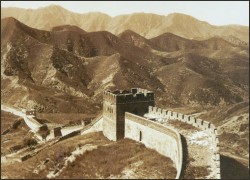The first wall to be built at the outer boundaries of the country was under emperor Che-huang-ti, who reigned between 221 and 206 BC, and partly used the already existing fortifications, but was not an uninterrupted wall. The cornerstones of this ancient defense system were the towers, made of huge bricks (48x48x18), 10mt high and 6 wide, connected to one another by ditches made of clay, gravel and tomarisco branches. In case invaders from Mongolia were sighted, from the towers signals would be sent , with huge flags by day and fire by night. The work required huge numbers of man: the emperor first employed 300,000 soldiers; then to speed the project, sent prisoners, and finally according to ancient chronicles one citizen out of three were obliged to work. Hundreds of thousands of these humble people must have died in the enormous project.
This first Great Wall did not however stop the Mongolian invaders in the following centuries, in the 13th century the Italian Marco Polo does not mention the Great Wall in his reportage, so at that time there were probably not many traces left. In the 14th century Gengis Khan conquered China, and his successors kept it for 90 years. Then in 1368 a rebellion began under the leadership of a Buddhist monk, the son of poor peasants, Chu-yuan-chang - who later become emperor as Tai-tsu founding the Ming dynasty. The Mongolian occupation was defeated, and the project of a new defense system took form.
Under the following Ming emperor the Great Wall as we know it today was built. On the Yellow Sea ships filled with iron and granite rocks were sunk, to serve as foundations for the part protruding on the sea, and all along the itinerary of the Wall two parallel walls were built with baked bricks, leaving an empty space in between some meters wide. The space between the two walls was then filled with earth, pressed clay, gravel and broken bricks, and the top was paved with bricks, and used as a road. At regular intervals sighting towers were erected, where a garrison of about 40 soldiers would stay permanently. At some points huge, guarded doors existed, to allow the transit of merchants but also for the troops that would be sent against the Tartars. The engineers did not worry about rivers, mountains, canyons: every obstacle was overcome.
See below a satellite image of the Wall almost at its beginning to the east of China; using the map controls or the mouse pointer the outline of the wall can be followed to the south and west.


